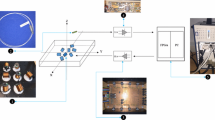Abstract
Nasogastric (NG) intubation is one of the most commonly performed clinical procedures. Real-time localization and tracking of the NG tube passage at the larynx region into the esophagus is crucial for safety, but is lacking in current practice. In this paper, we present the design, analysis and evaluation of a non-invasive real-time localization system using passive magnetic tracking techniques to improve efficacy of the clinical NG intubation process. By embedding a small permanent magnet at the insertion tip of the NG tube, a wearable system containing embedded sensors around the neck can determine the absolute position of the NG tube inside the body in real-time to assist in insertion. In order to validate the feasibility of the proposed system in detecting erroneous tube placement, typical reference intubation trajectories are first analyzed using anatomically correct models and localization accuracy of the system are evaluated using a precise robotic platform. It is found that the root-mean-squared tracking accuracy is within 5.3 mm for both the esophagus and trachea intubation pathways. Experiments were also designed and performed to demonstrate that the system is capable of tracking the NG tube accurately in biological environments even in presence of stationary ferromagnetic objects (such as clinical instruments). With minimal physical modification to the NG tube and clinical process, this system allows accurate and efficient localization and confirmation of correct NG tube placement without supplemental radiographic methods which is considered the current clinical standard.













Similar content being viewed by others
References
Amirlak, B., I. Amirlak, Z. Awad, M. Zahmatkesh, I. Pipinos, and A. Forse. Pneumothorax following feeding tube placement: precaution and treatment. Acta Med. Iran. 50(5):355–358, 2011.
Ananthanarayanan, A., S. Foong, and K. Sangbae. A compact two DOF magneto-elastomeric force sensor for a running quadruped. In: IEEE International Conference on Robotics and Automation, 2012, pp. 1398–1403.
Baldoni, J., and B. Yellen. Magnetic tracking system: monitoring heart valve prostheses. IEEE Trans. Magn. 43(6):2430–2432, 2007.
Breatnach, E., G. Abbott, and R. Fraser. Dimensions of the normal human trachea. Am. J. Roentgenol. 142(5):903–906, 1984.
Foong, S., K.-M. Lee, and K. Bai. Harnessing embedded magnetic fields for angular sensing with nano-degree accuracy. IEEE/ASME Trans. Mechatron. 17(4):687–696, 2011.
Gray, R., C. Tynan, L. Reed, J. Hasse, M. Kramlich, S. Roberts, J. Suneson, J. Thompson, and J. Nevlon. Bedside electromagnetic-guided feeding tube placement: an improvement over traditional placement technique? Nutr. Clin. Pract. 22(4):436–444, 2007.
Hanna, G., L. Phillips, O. Priest, and M. Ni. Improving the safety of nasogastric feeding tube insertion. A report for the NHS patient safety research portfolio. Patient Safety Research Portfolio, 2010.
Hensel, M., and R. Marnitz. Pneumothorax following nasogastric feeding tube insertion: case report and review of the literature. Der Anesthesist 59(3):229–234, 2010.
Joanna Briggs Institute. Methods for determining the correct nasogastric tube placement after insertion in adults. Best Pract. 14(1):1–4, 2010.
Kearns, P. Evaluation of diagnostic tests: verification of feeding tube placement using electromagnetic principles. Nutr. Clin. Pract. 12(1 Suppl):S61–S65, 1997.
Kearns, P., and C. Donna. A controlled comparison of traditional feeding tube verification methods to a bedside, electromagnetic technique. J. Parenter. Enteral Nutr. 25(4):210–215, 2001.
Kubik, S., and J. Healey. Surgical anatomy of the thorax (1st ed.). Philadelphia: WB Saunders, 1970.
Kuo, B., and D. Urma. Esophagus—anatomy and development. GI Motil. Online 2006. doi:10.1038/gimo6.
Lee, K.-M., and H. Son. Distributed multipole model for design of permanent-magnet-based actuators. IEEE Trans. Magn. 43(10):3904–3913, 2007.
Maréchal, L., S. Foong, S. Ding, D. Madhavan, K. Wood, R. Gupta, V. Patil, and C. Walsh. Optimal spatial design of non-invasive magnetic field-based localization systems. In: IEEE International Conference on Robotics and Automation, 2014, pp. 3510–3516.
Metheny, N., and K. Meert. Effectiveness of an electromagnetic feeding placement device in detecting inadvertent respiratory placement. Am. J. Crit. Care 23(3):240–247, 2014.
Sadjadi, H., K. Hashtrudi-Zaad, and G. Fichtinger. Fusion of electromagnetic trackers to improve needle deflection estimation: simulation study. IEEE Trans. Biomed. Eng. 60(10):2706–2715, 2013.
Stock, A., H. Gilbertson, and F. Babl. Confirming nasogastric tube position in the emergency department: ph testing is reliable. Pediatr. Emerg. Care 24(12):805–809, 2008.
Sun, Z., S. Foong, L. Maréchal, U.-X. Tan, T. Teo, and A. Shabbir. Design and analysis of a compliant non-invasive real-time localization system for nasogastric intubation. In IEEE/ASME International Conference on Advanced Intelligent Mechatronics, 2014, pp. 1091–1096.
Williams, S., and G. McDavid. Nasogastric tube errors. Casebook 20(3):10–12, 2012.
Wu, F., S. Foong, and Z. Sun. A hybrid field model for enhanced magnetic localization and position control. IEEE Trans. Mechatron. 20(3):1278–1287, 2015.
Wu, F., N. Robert, D. Frey, and S. Foong. Enhanced magnetic localization with artificial neural network field models. In IEEE International Conference on Robotics and Automation, 2013, pp. 1560–1565.
Wu, X., W. Hou, C. Peng, X. Zheng, X. Fang, and J. He. Wearable magnetic locating and tracking system for mems medical capsule. Sens. Actuators A 141(2):432–439, 2008.
Acknowledgments
This work was supported by the SUTD-MIT International Design Centre Research Grant IDSF2100107OH and the Singapore University of Technology and Design Start-up Grant SRG EPD 2011 007. This project is facilitated by the robotic platform from the SUTD-ZJU Research Collaboration Grant SUTD-ZJU/RES/03/2012.
Author information
Authors and Affiliations
Corresponding author
Additional information
Associate Editor John H. Linehan oversaw the review of this article.
Rights and permissions
About this article
Cite this article
Sun, Z., Foong, S., Maréchal, L. et al. A Non-invasive Real-time Localization System for Enhanced Efficacy in Nasogastric Intubation. Ann Biomed Eng 43, 2941–2952 (2015). https://doi.org/10.1007/s10439-015-1361-0
Received:
Accepted:
Published:
Issue Date:
DOI: https://doi.org/10.1007/s10439-015-1361-0




